A timeline of papal visits to Africa: From Paul VI to Francis
As Pope Francis visits the DRC and South Sudan, we take a look at previous papal voyages to the continent.
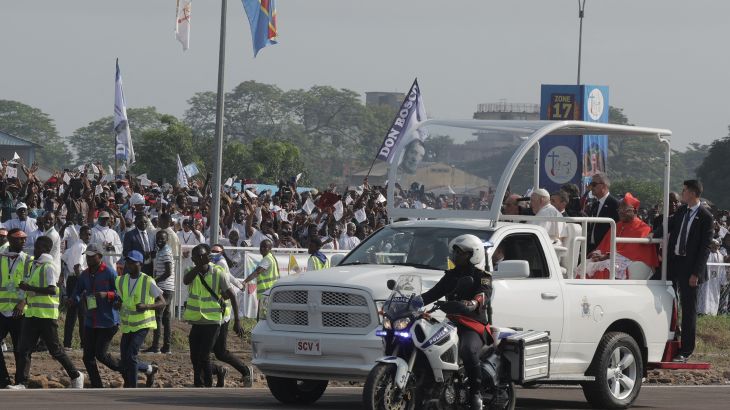
Pope Francis is visiting the Democratic Republic of the Congo and South Sudan, his fifth trip to Africa since being elected head of the Catholic Church in 2013.
The 86-year-old had to postpone the trip last year after suffering knee problems. But he was determined to undertake the visit, which will bring to 10 the number of African countries he has visited.

Keep reading
What did the pope say in his ‘state of the world’ address, ‘we are all children of god’: pope says homosexuality not a crime, south sudan’s displaced hope pope’s visit will bring peace.
We take a look at previous papal visits to the continent.
Pope Paul VI
1960: uganda.
In the 1960s, popes didn’t travel much outside Vatican City. Pope Paul VI bucked the trend and became the first reigning pope to visit Africa.
It was a major event when he visited Uganda in 1969. Among other activities, Paul VI made a pilgrimage to the Uganda Martyrs Shrine Namugongo. During his visit, twenty-two Catholic martyrs were canonised.
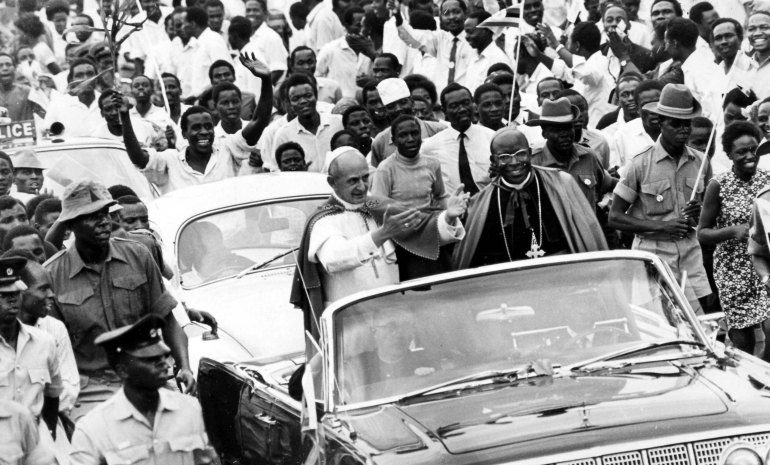
Pope John Paul II
Pope John Paul II travelled widely throughout Africa during his more than 26-year pontificate. His first tour was in 1980.
1980: The Democratic Republic of the Congo, the Republic of the Congo, Kenya, Ghana, Burkina Faso, and Ivory Coast
During his first African tour, he visited six countries in 11 days. At the time the Democratic Republic of the Congo was known as Zaire and Burkina Faso was known as Upper Volta.
In Ouagadougou, the capital of Upper Volta, he made an appeal for international assistance for the country as it suffered a devastating drought. The donations received set in place the foundations for the establishment of the John Paul II Foundation for the Sahel in 1984.
During his trip, he reportedly criticised Marxism as an ideology and welcomed the religious enthusiasm he encountered.
On his last day, he also said : “There is a great temptation to demolish instead of building, to procure weapons at a great price for populations that need bread, to want to seize power – sometimes confronting one ethnic group with another … while the poor sigh for peace, succumb to the desire for profit benefitting a privileged class.”

1982: Nigeria, Benin, Gabon, and Equatorial Guinea
John Paul II’s second tour took place in February 1982, nine months after an attempt on his life.
In Benin where church-state relations were rocky, he listened as President Matthieu Kerekou delivered a lecture on ‘the socialist struggle’, according to the UPI news agency. He then celebrated mass for approximately 20,000 people at the stadium in Cotonou.
After five days in five Nigerian cities, including Lagos and Onitsha, the pope said the visit left him with “‘an unforgettable memory of a country which is a credit to Africa, to the world and to the church of Jesus Christ”.
In the northern city of Kaduna, he called for unity at a gathering of Muslim religious leaders, saying: “All of us, Christians and Muslims, live under the sun of the one merciful God.”
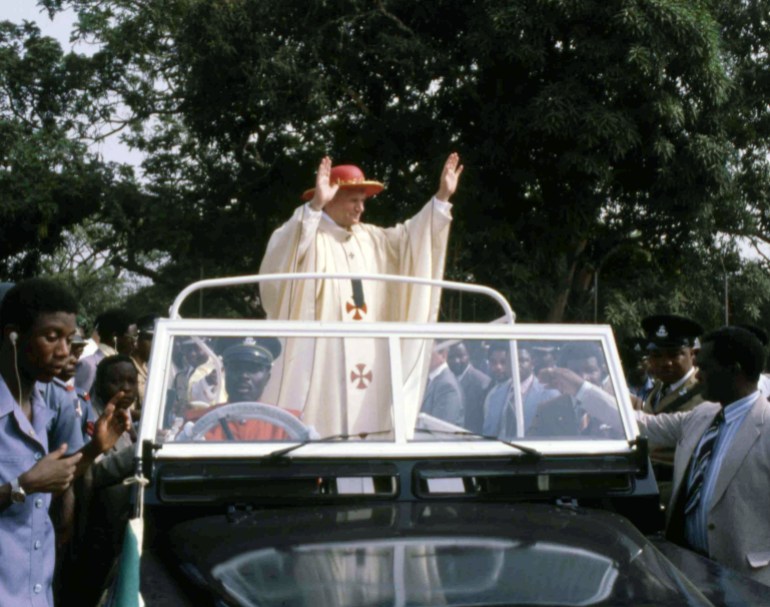
1985: Togo, Ivory Coast, Cameroon, Central African Republic, Democratic Republic of the Congo, Kenya, Morocco
This third tour of Africa was in August 1985, and his 27th trip outside Italy.
During this tour, he dedicated the biggest church in the world, the Basilica of Our Lady of Peace in Yamoussoukro, the capital of Ivory Coast. During his visit to the country five years earlier, he had blessed the foundation stone as construction began.
In a homily in Lome, the Togolese capital, he said he wanted to preach a faith that was ”authentically Christian and authentically African” in response to the matter of Catholicism adapting to traditional African practices.
He ended the tour with a plea to Muslims and Christians to put aside their differences and work together to create a better world.
1988: Zimbabwe, Botswana, Lesotho, Eswatini, Mozambique
During this trip, Pope John Paul II arrived in the Kingdom of Lesotho before a bloody shootout between police and gunmen who hijacked a busload of nuns and children while demanding to see the pope.
The pope arrived in Lesotho eight hours behind schedule and just 20 minutes before the tense hostage drama was resolved. One hostage died and eleven others were wounded but the others were rescued.
According to reports, the religious leader condemned apartheid in South Africa during this trip – in Lesotho.
“A civilization of justice, peace and love mean recognition of the dignity of each human being,” he was quoted as saying. “It means each human being can exercise fundamental rights without restrictions or limitations supposedly justified by racial segregation or by social discrimination.”
He also visited eSwatini, then still known as Swaziland.
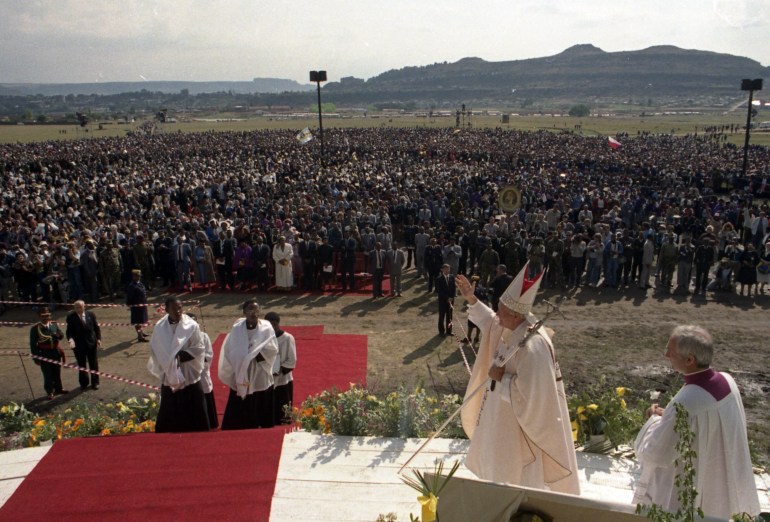
1989: Madagascar, Reunion, Zambia, Malawi
This was his fifth trip to Africa as a Pope and his 41st trip outside Italy.
According to reports, his interest in Africa was driven largely by the rapid expansion of the Church during those years. Vatican sources said the church gained 2.5 million new adherents in Africa in 1989 alone.
There was also the beatification of Victoria Rasoamanarivo – a member of the Malagasy elite who encouraged Catholica communities at a time when Christianity was outlawed in the country – as a saint in Antananarivo, Madagascar.
1990: Cape Verde, Guinea Bissau, Mali, Burkina Faso, Chad, Tanzania, Burundi, Rwanda, Ivory Coast
In 1990, John Paul II made two trips to Africa. In January that year, he went to Cape Verde, Guinea Bissau, Mali, Burkina Faso, and Chad.
In September, he travelled to Tanzania, Burundi, Rwanda and Ivory Coast.
In Tanzania, where one million of its 24 million people were living with AIDS, the pope stressed the need for a ”supreme effort of cooperation among governments as well as the scientific and medical communities”.
1992: Senegal, Gambia, Guinea, Angola
This was his 8th tour of Africa.
His visit to Angola coincided with the 500th anniversary of the coming of Christianity to the Central African country.
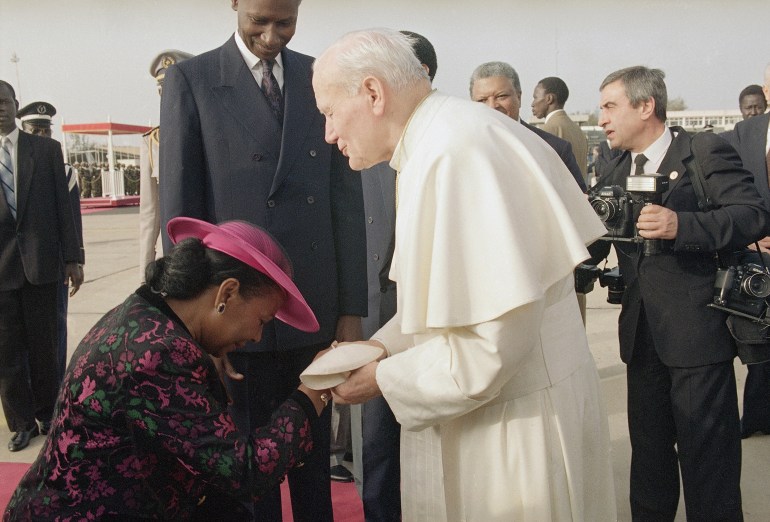
1993: Benin, Uganda, Sudan
During his 9th tour to Africa, John Paul II said the Vatican would strongly resist the imposition of Islamic law on Christians in Sudan.
“You absolutely cannot impose this law on those of other faiths who are Christian,” the 72-year-old Pope told reporters, according to a report by the New York Times.
“The role of the church, the Holy See and the bishops is to remind leaders of Muslim countries that Islamic law can be applied only to the Muslim faithful,” he said.
1995: Cameroon, South Africa, Kenya
Catholics in South Africa will long remember the historic visit by Pope John Paul II.
A longstanding opponent of apartheid, the pope refused several invitations to visit South Africa. But this time, he was received by the late President Nelson Mandela, the country’s first Black president, who praised his stand against apartheid.
“Today my journey brings me to a new South Africa, a ‘rainbow nation,’ indicating the diversity of races, ethnic groups, languages and culture which characterise it,” the pope said.
1998: Nigeria
This was his last trip to sub-Saharan Africa at the age of 77.
During his trip, he encouraged human rights within the country which was then under the authoritarian rule of the late Sani Abacha.
“Respect for every human person, for his dignity and rights, must ever be the inspiration and guiding principle behind your efforts to increase democracy and strengthen the social fabric of your country,” he said in a mass in Abuja.
“The dignity of every human being, his inalienable fundamental rights, the inviolability of life, freedom and justice, the sense of solidarity and the rejection of discrimination: these must be the building blocks of a new and better Nigeria,” he added.
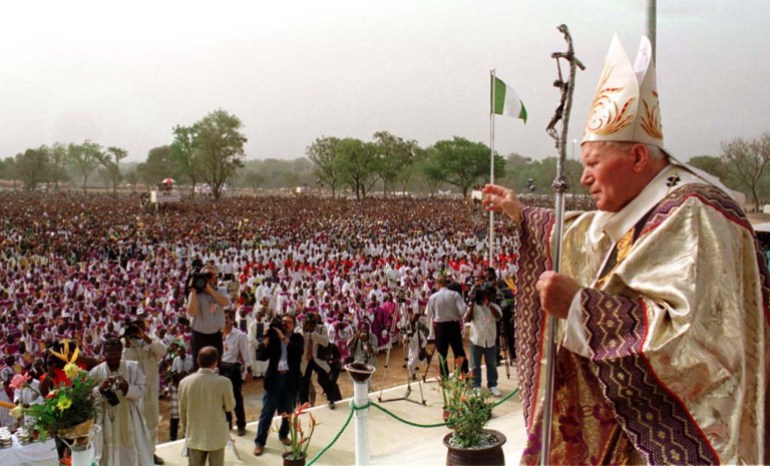
2000: Egypt
This trip was his first visit to the country.
The pope was greeted by Egyptian President Hosni Mubarak with a handshake at the foot of the plane’s stairs as he stepped onto the tarmac at Cairo International Airport.
A band played the processional from Verdi’s Aida, an opera associated with Egypt, as Mubarak then escorted the pope, leaning on a walking stick, to stand before the flags of Egypt and the Vatican.
“We never could have imagined that we would have the pope under our roof,″ said Samir Yassa, who designed the New Cathedral of Our Lady of Egypt where the pope met with Orthodox and Coptic clergymen in a display of their shared roots. “A brother is returning to a land where Christ walked.″
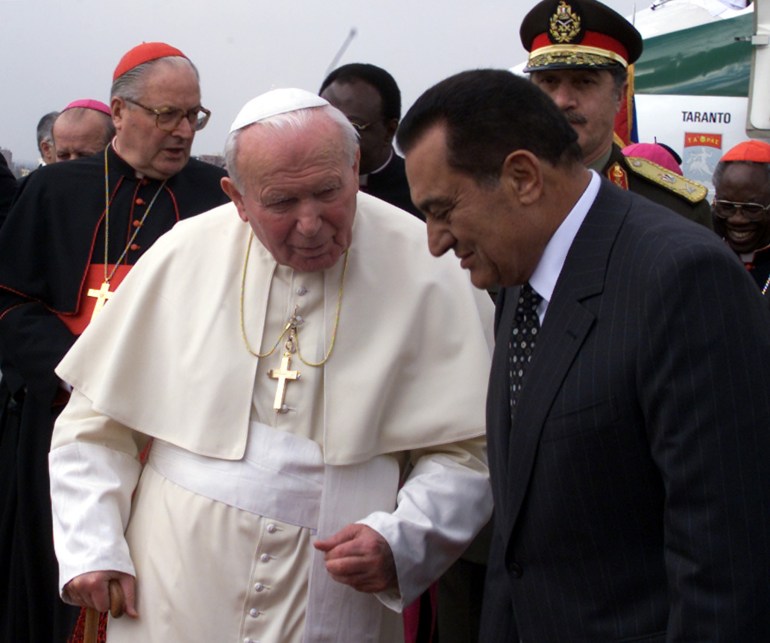
Pope Benedict XVI
2009: cameroon, angola.
On Pope Benedict’s first trip to Africa, he urged Angolans, still recovering from nearly three decades of civil war in their oil-rich country, to build peace and understanding between peoples.
“Dear Angolans, your land is abundant, and your nation is mighty. Make use of these advantages to build peace and understanding between peoples,” the pope said.
“To this end, I ask you: do not yield to the law of the strongest! God has enabled human beings to fly, over and above their natural tendencies, on the wings of reason and faith.”
The Pope’s rejection of the use of condoms in the fight against HIV/AIDS sparked controversy during this trip.
2011: Benin
His last tour to Africa was a three-day visit to Benin at a time when the Catholic Church was growing faster than on any other continent.
At the end of 2011, the Catholic population worldwide reached 1.2 billion. According to America Magazine, there was a 4.1 percent increase in Catholics in Africa, twice the change in Asia, the second fastest-growing Catholic population globally.

Pope Francis
2015: kenya, uganda and central african republic.
The Argentine-born pontiff made his first trip to Africa in November 2015, with a six-day visit to Kenya, Uganda and Central African Republic (CAR).
He brought with him a message of peace, social justice and dialogue with Islam on a trip that included a visit to a Nairobi slum and a mosque in the CAR capital Bangui.
In CAR, he urged warring factors to lay down their weapons and hailed Africa as “the continent of hope”.
2017: Egypt
In April 2017, Pope Francis paid a two-day visit to Cairo in support of the largest Christian community in the Middle East, the Coptic minority in Egypt, who have been subject to marginalisation and deadly attacks for years.
He also reached out to Islamic leaders, visiting Al Azhar, the centre of Sunni Muslim learning presided over by its grand imam, Ahmed al-Tayeb – one of Islam’s leading religious authorities.
2019: Morocco
At the invitation of King Mohammed VI, Francis visited the North African country of Morocco in March 2019.
His trip was marked by calls for religious tolerance, freedom of religion and also respect for the rights of refugees and migrants.
He also warned the Christian faithful against trying to convert others, preaching “no proselytism” ahead of a mass for thousands of Catholics in Rabat.
Pope Francis praises Uganda’s welcome of refugees
By Devin Watkins
Uganda’s Prime Minister Robinah Nabbanja met on Monday with Pope Francis at the Vatican’s Apostolic Palace.
The encounter lasted around 25 minutes and saw the Pope and the prime minister discuss various issues, according to Matteo Bruni, the Director of the Holy See Press Office.
“Among the topics covered during the conversation, the Pope was touched by the welcome generously extended by Ugandan institutions to migrants and refugees, not only from the African region, but as far as Central Asian countries,” he said.
Uganda hosts some 1.5 million refugees and asylum seekers, according to the UN’s refugee agency, UNHCR. Many of them hail from South Sudan, the Democratic Republic of Congo, and Burundi.

Gifts symbolizing peace
Pope Francis and Ms. Nabbanja also engaged in the customary exchange of gifts.
The Pope gave Uganda’s prime minister a bronze statue representing a dove carrying an olive branch in its beak. The statue bears the inscription: “Be messengers of peace”.
He also offered Ms. Nabbanja copies of several papal documents, including the Pope’s message for this year’s World Day of Peace, the Document on Human Fraternity, and a book on the Statio Orbis on 27 March 2020, published by the Vatican’s Publishing House.

Thank you for reading our article. You can keep up-to-date by subscribing to our daily newsletter. Just click here

More upcoming events:
The Pope's Agenda

Listen to our podcasts

Subscribe to our newsletters
To get the latest news

Regina Coeli

Papal audiences

Daily readings

Saint of the day

How Pope Francis’ Trip Retraces the First Papal Visit to Africa
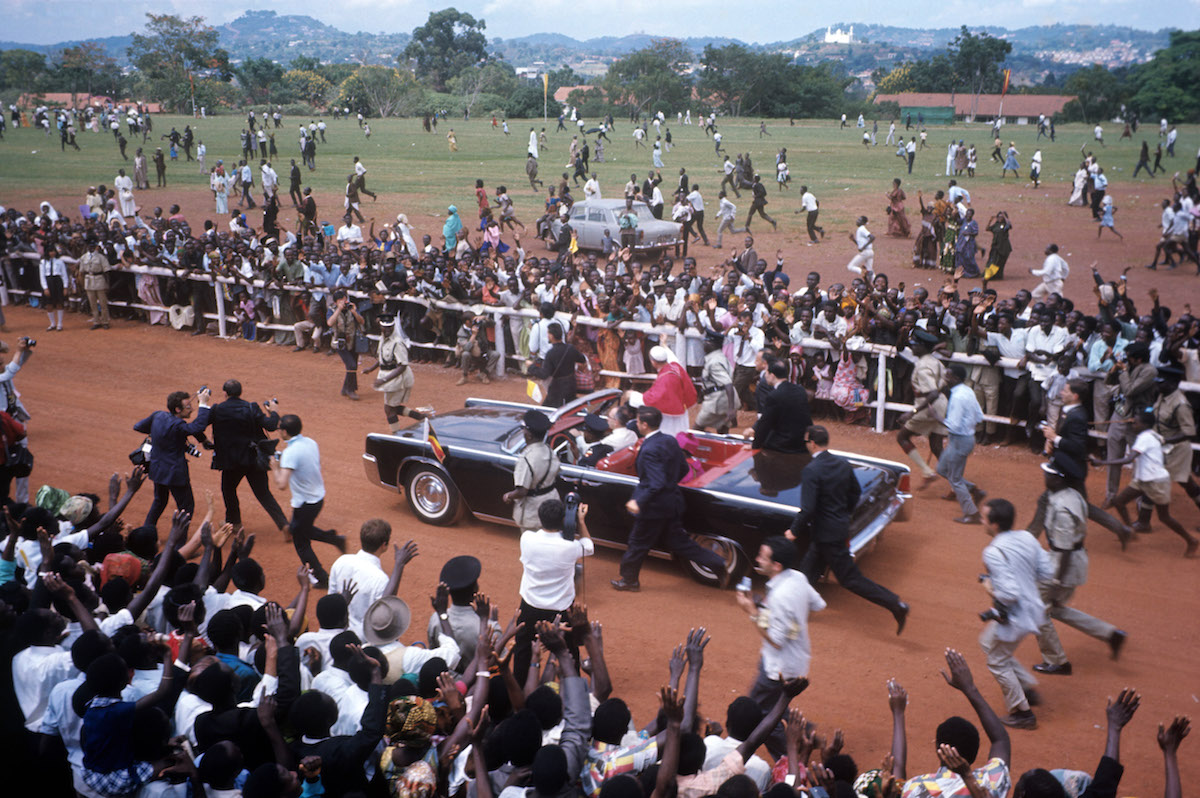
T he crowd at the Entebbe airport had been waiting for hours, but spirits were high — drummers, singers and dancers milled about while the Police Band prepared to perform the Ugandan National Anthem. The Ugandan President was on hand to greet the celebrated guest, along with four other heads of African states. Then Paul VI touched down on the tarmac, and on July 31, 1969, became the first reigning Pope to ever visit Africa.
“Roman Catholics number about 3,000,000 in Uganda—one of Africa’s most Christianized countries,” TIME reported in the next issue, “But during the visit of Pope Paul VI last week, it seemed as if all of its 9,000,000 citizens had become instant Romans.”
On Wednesday, Pope Francis will travel to Africa for his first papal visit to that continent. The visit comes nearly half a century after Paul’s, but Francis’ route in Uganda will retrace some of his predecessor’s steps.
Paul was primarily concerned with working towards peace for the Nigerian Civil War, TIME reported, but the trip to Uganda was planned so he could dedicate a shrine to 22 African Catholic martyrs. At the time, the Catholic Church in Africa was rapidly growing and Paul’s meetings with church leaders focused largely on increasing the independence of the developing communities. “You are missionaries to yourselves now,” said the Pope. This time around, Pope Francis will also address an ongoing civil war and an evolving Catholic population .
In Namugongo, Paul dedicated the partially-built Uganda Martyrs Shrine and celebrated the Mass with more than 100,000 people. Francis will visit that same basilica to celebrate Mass on Nov. 28.
And at least one other element of that 1969 trip is sure to be repeated too: the excitement. As TIME reported, Paul’s visit was the occasion for much rejoicing:
It was the first time that a reigning Pontiff had ever visited Africa, and for Uganda, the host country, it was the biggest event since the nation won its independence from Britain in 1962. …There were Pope Paul coins, Pope Paul stamps and Pope Paul folk songs, including a pop calypso that likened the Pontiff’s visit to “a shooting star in the dark of the night.” Shop-door signs along the papal route proclaimed “Pepsi Welcomes the Pope.”
Read the full story from 1969, here in the TIME Vault: A Sacred Safari for the Pope
More Must-Reads From TIME
- Exclusive: Google Workers Revolt Over $1.2 Billion Contract With Israel
- Jane Fonda Champions Climate Action for Every Generation
- Stop Looking for Your Forever Home
- The Sympathizer Counters 50 Years of Hollywood Vietnam War Narratives
- The Bliss of Seeing the Eclipse From Cleveland
- Hormonal Birth Control Doesn’t Deserve Its Bad Reputation
- The Best TV Shows to Watch on Peacock
- Want Weekly Recs on What to Watch, Read, and More? Sign Up for Worth Your Time
Write to Julia Zorthian at [email protected]
Watch CBS News
Pope Francis urges Catholics to follow zeal of Uganda martyrs
November 28, 2015 / 10:51 AM EST / CBS/AP
NAMUGONGO, Uganda -- Pope Francis on Saturday honored the Ugandan Christians who were burned alive rather than renounce their faith a century ago, urging today's Catholics to follow in their missionary zeal and spread the faith at home and abroad.
A somber Francis prayed at shrines dedicated to the 23 Anglican and 22 Catholic martyrs who were killed between 1885 and 1887 on the orders of a local king trying to thwart the influence of Christianity in his central Ugandan kingdom. According to historians, the Christians were also killed because they refused the king's sexual advances, citing the church's opposition to homosexuality.
At Namugongo, outside the capital, Kampala, where most of the martyrs were burned alive, Francis prayed first at the gruesome sanctuary dedicated to the Anglicans, kneeling before part of the same tree where they were tortured before being executed. He then prayed at the Catholic shrine and celebrated Mass in their honor to mark the 50th anniversary of the Catholics' canonization.
How badly the faithful wanted to see and hear the pope was evidenced by prime spots packed literally cheek to cheek, CBS News correspondent Allen Pizzey reports.
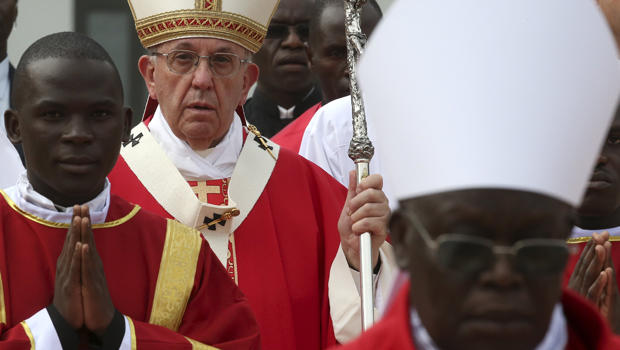
But the church isn't having it all its own way here, Pizzey reports. Some 40 percent of Ugandans are Catholics, but a mere 20 percent of couples are legally married. The rest cohabit in what the church delicately terms "irregular situations."
It's more or less the way the church also refers to homosexuality, which is a raging issue here, Pizzey reports. Uganda has some of the most severe anti-homosexuality laws in Africa, including a proposed one that would have imposed the death penalty but which the church successfully lobbied against.
As many as 2 million people were expected to attend the Mass, including Ugandan President Yoweri Museveni, the president of South Sudan and the descendant of the king who ordered the deaths.
Francis urged them to use the martyrs' example of faith to be missionaries at home by taking care of "the elderly, the poor, the widowed and the abandoned."
"This legacy is not served by an occasional remembrance or by being enshrined in a museum as a precious jewel," he said. "Rather we honor them and all the saints when we carry on their witness to Christ, in our homes and neighborhoods, in our workplaces and civil society, whether we never leave our homes or we go to the farthest corner of the world."
The Argentine pope knows of what he speaks. When he joined the Jesuit order as a young man, he longed to be a missionary in Japan. But his superior told him to stay home for health reasons, and he later developed a ministry in the slums of Buenos Aires that has formed the basis of his papacy.
During his two days in Uganda, Francis is expected to touch on some of the same themes he emphasized during the first leg of his trip in Kenya: corruption, poverty and giving young Christians hope and encouragement. After the Mass on Saturday, Francis has a rally with young people, a visit to a charity and a meeting with local priests, seminarians and nuns on his agenda.
Some of the pilgrims attending the Mass had been here all night to honor the martyrs and see the pope, braving rains and sleeping on mats to guard against the mud that turned the grounds into chocolate-colored muck.
"They are so important because they sacrificed their life because of their religion," said Beneh Ssanyu, 27, who showed off the mud encrusting her sandals and pants - evidence of her arrival at 1 p.m. Friday that scored her a prime front-row seat.
Security at the shrine was tight, with those entering the main area passing through metal detectors and police boats monitoring the moat surrounding the altar where Francis celebrated the service.
Francis has made a point on his foreign travels to honor local martyrs in hopes of inspiring a new generation of missionaries. When he was in South Korea, for example, he beatified 124 missionaries who helped bring the faith to the Korean Peninsula. He has also spoken out frequently about today's martyrs, the Christians in the Middle East and Africa who have been slaughtered by Muslim militants.
The history of Uganda's martyrs has helped shape the Catholic Church here, with huge numbers of pilgrims flocking to the Namugongo shrine, many of them Africans arriving from as far away as Congo and Tanzania. Most of the pilgrims walk long distances to the site to underscore their faith.
King Mwanga II of Buganda Kingdom ordered the martyrs killed during a period of political and religious turmoil as he tried to assert his authority amid the growing influence of missionaries from Europe.
But the history of the martyrs also shows a personal grudge Mwanga held against them: After the martyrs converted to Christianity, they began rebuffing his sexual advances since church teaching forbid homosexuality - a humiliation that was part of the reason they were ordered killed, according to the history of the killings, "African Holocaust" by J.F. Faupel.
"It is absolutely true. It is a fact," said Bishop Giuseppe Franzelli, a longtime Italian missionary in Uganda. "When they became Christians, they saw that this was not according to the Gospel, the teaching of Christ and they said no."
The little-known history might help explain why homosexuality remains so taboo today in Uganda.
The Vatican has refused to say whether Francis will discuss gay rights openly while here.
On Sunday, Francis heads to his final destination, the Central African Republic.
More from CBS News
Pope's visit to Uganda: dates released
Jun 20, 2015
Pope Francis will come to Uganda and also go to the Central African Republic in November on his first visit to Africa.

Pope Francis will come to Uganda and also go to the Central African Republic in November on his first visit to Africa, the Vatican announced Friday. The Argentinian pontiff has said several times in recent months that he intended to travel to Africa this year. "If God permits it I will be in Africa in November, in the Central African Republic and in Uganda," he said earlier this month. The confirmed dates of November 27-29 were posted Friday on the official Vatican website. The announcement of the visit to the Central African Republic came as the authorities there said presidential and legislative elections would take place in October and November -- finishing the week before he arrives. Francis will be in Uganda to mark the 50th anniversary of Pope Paul VI's canonisation during the first visit by a pontiff to Africa of 22 Catholic martyrs -- converts to Christianity who were executed in the 19th century. The Central African Republic is seeking to emerge from brutal inter-religious violence in 2013-2014 which left thousands dead, while Uganda remains under threat of attack from Al-Qaeda-affiliated Shebab Islamists from neighbouring Somalia. After visits to Sri Lanka and the Philippines in January, Pope Francis is due to visit Ecuador, Bolivia and Paraguay next month. In September, he will travel to Cuba and the United States. AFP Meanwhile, 22 years ago . . . February 7, 1993: Pope John Paul II blesses Ugandans at a mass in Namugongo, on the third day of his five-day visit to Africa. Later that day the pope was scheduled to visit Nsambya hospital and meet with AIDS victims
February 9, 1993: Here, Pope John Paul II, surrounded by dancers, waves to faithful during his visit to Uganda
And even much earlier, in 1969 . . .
Pope Paul VI visited Uganda in 1969, a trip that came five years after he had canonized the Uganda Martyrs in Rome on October 18, 1964. Here, the pope blessed a woman at Namugongo
During his visit to Uganda, Pope Paul VI also addressed the Parliament More on Pope Francis 'Act before climate change destroys planet' The green vision of Pope Francis
- Skip to main content
- Keyboard shortcuts for audio player
Goats and Soda
- Infectious Disease
- Development
- Women & Girls
- Coronavirus FAQ
Dear Pope Francis, As You Visit Uganda, Here's What You Should Know
James Kassaga Arinaitwe
Viviane Rutabingwa

A vendor arranges portraits of Pope Francis outside the Lubaga Cathedral in Kampala, Uganda, in preparation for the papal visit. Isaac Kasamani/AFP/Getty Images hide caption
A vendor arranges portraits of Pope Francis outside the Lubaga Cathedral in Kampala, Uganda, in preparation for the papal visit.
Dear Pope Francis,
We're excited to welcome you to Uganda. Catholics make up nearly half of the Christian population here — and they're eager to meet you!
Our's is a lovely country. Buzzfeed ranked us the 13th most beautiful country in the world! (But of course, we think it's No. 1.)
Still, Uganda has got its fair share of problems — especially when it comes to health care, human rights and education. We're hoping you can use your influence to galvanize our young people and push our nation's leaders to fix some of these issues. Here's what we're thinking about:
Health Care
When you arrive at our infamous Entebbe International Airport, it may reassure you to know that just a few months ago, Uganda initiated heightened Ebola screening for everyone coming into the country. This set-up includes a mobile medical center that offers counseling and clinical screening, a stand-by ambulance and protective gear.
But our health care system is far from perfect. That's why our leaders and wealthy citizens travel to India, Dubai and Europe for their health care. Not to mention that a study in 2013 found that nearly 50 percent of our registered medical practitioners have left the country over the past 10 years.
So as the presidential elections draw close, we would love to see our leaders put more emphasis on improving our health system. Right now, patients are forced to pay bribes or go without care. Our leaders must fight this sort of corruption , which undermines the health of millions of vulnerable citizens
Infrastructure
Our nice new highways were made possible by Chinese loans . We are happy to be rid of aid from the International Monetary Fund, which came with generally higher interest rates and and lots of strings attached.
But our roads could use some improvement: We lose thousands of lives annually to traffic accidents. We need safety standards for pedestrians and cyclists and better traffic laws.
As you pass by our city schools, know that we have an 89 percent youth literacy rate . Ugandans are passionate about learning.

A Pope's Visit May Bring Hope, But Does It Also Bring Change?
But due to our underfunded public education system , many kids are falling through the cracks. No child should go to school hungry or attend class under a mango tree. Yet this still happens.
We hope you mention that to our leaders. If they really want Uganda to become a middle-income nation by 2020, they must invest in education for all.
And while you're at it, could you maybe nudge our leadership to build up job training centers and bring in more industries that will employ our unemployed? Vibrant, energetic young people make up more than three-quarters of our population — and many of them need to work.
When you visit the Namugongo shrines, which commemorate Ugandan martyrs who died for their Christian faith, remember how deeply spiritual Ugandans of all faiths are. We have a long tradition of religious diversity; Uganda is home to everyone from Bahais to Orthodox Christians.
Lately American evangelical missionary groups have exploited our spirituality by promoting bigotry and funding Ugandan campaigns to limit gay rights. We hope you, as a spiritual leader, keep spreading your message of acceptance. As you told a journalist recently: "If a person is gay and searches for the Lord and has good will, who am I to judge?"
We hope you will inspire Ugandan clergy, politicians and youth and challenge our leadership to go beyond the hype of their rhetoric and ensure all East Africans will soon live in dignity, peace and tranquility.
James Kassaga Arinaitwe and Viviane Rutabingwa
James Kassaga Arinaitwe is the cofounder of Teach for Uganda, and a 2014 Aspen Institute New Voices fellow and 2015 Global Fellow at Acumen . Viviane Rutabingwa is a public health professional with a focus on the uninsured and refugees. She is a Global Health Corps alumni and a founding member of A Place for Books. You can follow them on Twitter: @JamesArinaitwe and @Rootsi.
- Pope Francis
Pope ends visit to Uganda, travels to Central African Republic

Pope Francis has ended his visit to Uganda and tomorrow morning he will board the plane that will take him to the conflict-ridden Central African Republic, as “a messenger of peace.”
On his last day in Uganda, he repeatedly urged Christians here to draw inspiration from their martyrs. From early morning to late evening, Saturday Nov. 28, Pope Francis highlighted in different ways the cost of Christian discipleship, yesterday and today, in this land that is known as "the pearl of Africa."
As he had explained on arrival, his main purpose in coming to Uganda was to commemorate the 50th anniversary of the canonization of the Catholic martyrs of Uganda. But aware that there were also Anglican martyrs who were executed in the same place and at the same time, Francis set out to honor the memory of both, and what he likes to call “the ecumenism of blood.”
He began the day by traveling ten miles from Kampala to Namungongo, where there are both Catholic and Anglican shrines. He went first to the Anglican one and was welcomed by the Anglican bishops, one of whom gave him a guided tour of the shrine. The bishop showed him the recently created museum that offers striking representations of the torture and death that the martyrs had suffered.
Francis’ face betrayed inner anguish as he listened to what had happened and at the end of the explanation he knelt down in front of a tree at the spot where the 45 martyrs, both Anglican and Catholic, were tortured before being executed between 1885 and 1887. He prayed there in silence for several minutes, and when he got up he appeared to be in another dimension, one might say in a state of profound reflection. He then walked downstairs to the crypt, to pray at the tomb of the Anglican martyrs.
From the Anglican shrine, Francis traveled by popemobile to the Catholic shrine to celebrate Mass for some three hundred thousand faithful gathered there at a specially constructed altar, overlooking an artificial lake in a large park not far from the actual shrine.
Uganda’s Catholics were truly delighted that he had come among them, and they gave full expression to that joy during the Mass by applauding enthusiastically after every prayer and reading, and even when the pope began the Mass with the sign of the cross. It was a real festive celebration, and followed on the sense of fiesta evident on his arrival, which I mention in my report yesterday.
Francis delivered his homily in Spanish, and the Vatican monsignor accompanying him—Mark Myles—provided the English translation. In it, he recalled how from the time of the apostles “a great cloud of witnesses had been raised up to proclaim Jesus and show forth the power of the Holy Spirit.” Among them were the Ugandan martyrs—“both Catholic and Anglican”—who gave ecumenical witness to Christ. The Catholic martyrs were all laypeople, and the Francis mentioned two of them—Saints Joseph Mkasa and Charles Lwanga “who after being catechized by others, wanted to pass on the gift they had received.”
Francis likes this “missionary zeal”—something he emphasized also in the last public event of his stay here in Uganda. He did so when he spoke in the cathedral to priests, men and women religious as well as seminarians. He wants the church to be “missionary.” He recalled how the two martyrs “were fearless in bringing Christ to others, even at the cost of their lives.”
He said the faith of the Ugandan martyrs “became witness” and “their example continues to inspire people throughout the world.”
Pope Francis told the Catholics of Uganda “the witness of the martyrs shows to all who have heard their story, then and now, that worldly pleasures and earthly power do not bring lasting joy or peace.”
On the other hand, he said, “fidelity to God, honesty and integrity of life, and genuine concern for the good of others bring us that peace which the world cannot give.”
This, he said, “does not diminish our concern for this world, as if we only look to the life to come. Instead, it gives purpose to our lives in this world, and helps us to reach out to those in need,” in particular “to the widows and the orphans,” and “to cooperate with others for the common good, and to build a more just society which promotes human dignity, defends God’s gift of life and protects the wonders of nature, his creation and our common home.”
That is “the legacy” that Christians in this land “have received from the Uganda martyrs,” Francis declared. Later that day he made the same point in the cathedral when he told the priests and religious “this legacy is not served by an occasional remembrance, or by being enshrined in a museum as a precious jewel.”
Instead, he said, “we honor them, and all the saints, when we carry on their witness to Christ, in our homes and neighborhoods, in our workplaces and civil society, whether we never leave our homes or we go to the farthest corner of the world. ”
His message did not need interpreters. He reinforced it that same afternoon when he spoke to 150,000 young people, among them Protestants and Muslims, at a former airfield on the outskirts of Kampala, at a rally marked by excitement, enthusiasm and obvious love for Francis. After listening to testimonies from two of them—a young woman whose family was destroyed by HIV and a young man who had been a prisoner of the Lord’s Resistance Army, Francis reminded them that they have “the blood of the martyrs in your veins” and should take inspiration for their lives from that memory. He told them that with the help of Jesus they can—like those two young people—transform negative experiences in their lives into positive ones. He assured them that if they pray to Jesus regularly, then they would get that help.
He communicated that same message to the priests, men and women religious, and seminarians when at the end of the day he met them in the cathedral, and reminded them that they too, like all the Catholics of Uganda, “have the blood of the martyrs in your veins.”
Putting aside his prepared text, he offered “three pillars” on which to build their lives as witnesses to the Gospel. Those pillars are: Do not forget (the memory of the Ugandan martyrs); be faithful (to that memory and to their own vocations); and pray. If they build their lives on those three pillars, he said, then the memory of the martyrs will not be something that is consigned to a museum.
It is clear from what he said here in Uganda, and what he said last year in South Korea, that Francis believes firmly that the blood of the martyrs is “a seed” that can lead to change, and to the revolution of tenderness and love that he is repeatedly calling for in the lives of Christians and in the church.
Pope Francis developed his message even further in the brief talk that he gave when he visited a famous charitable center at Nalukolongo, run by the Good Samaritan Sisters, which cares for more than 100 poor people—Christians and Muslims alike, with various disabilities and ages ranging from 12 to 107, many of whom have been discarded by society.
He issued an appeal from this center to all parishes and communities in Uganda, and in the rest of Africa, “not to forget the poor.”
He reminded everyone that “the Gospel commands us to go out to the peripheries of society, and to find Christ in the suffering and those in need.” He said many of them are “victims of today’s throwaway culture, which breeds contempt above all towards the unborn, the young and the elderly! ”
Pope Francis concluded by affirming that “as Christians we cannot simply stand by. Something must change! Our families need to become ever more evident signs of God’s patient and merciful love, not only for our children and elders, but for all those in need. Our parishes must not close their doors, or their ears, to the cry of the poor.”
After giving his talk, Francis made a private visit, far from the gaze of the media, to 10 young children at the center that are suffering from serious illnesses and disabilities. He kissed each of them, and sought to communicate his closeness to them. His witness here, as on other occasions, gives real credibility to his words and makes his message even more attractive.
Francis’ visit to Uganda effectively concluded at the cathedral. There is a brief farewell ceremony at Entebbe airport tomorrow morning, Sunday, Nov. 29, after which he boards the Alitalia plane that will take him to the Central African Republic.
There has been opposition to his visit here, and it has become clear that some with vested interests do not want him to come because his presence here will bring international attention to the dramatic situation in this country, which is rich in minerals such as uranium, diamonds and oil, but at the present moment it is to all intents and purposes a failed state.
Pope Francis is deeply concerned at the dramatic situation of children, women and men in this country, and all along he has been determined to go to the Central African Republic in the hope that he can make a contribution to bringing a just and lasting peace here.
An indicator of his determination emerged on the flight from Rome to Nairobi when, talking with the pilots of the Alitalia plane that he is using on this trip, Francis in his humorous way told them, “if you don’t want to take me to Bangui then give me a parachute and I will parachute in!”
There is no need for the parachute. His plane is scheduled to touch down at 10.00 a.m. (local time) at Bangui’s international airport tomorrow, Sunday, Nov. 29.


Most popular

Your source for jobs, books, retreats, and much more.
The latest from america
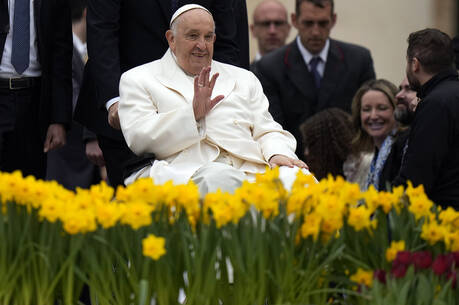

Social Menu

Pope Francis and Archbishop Stanley Ntagali at the Anglican Shrine to the Ugandan Martyrs in Namugongo. Photo: Petero Buyondo and Francis Emorut
[Anglican Communion News Service] Pope Francis has made a visit to the Anglican shrine to the Ugandan Martyrs in Namugongo, and spoke of the “ecumenism of blood”.
The Pope looked visibly pained and shocked as Archbishop Stanley Ntagali, primate of the Anglican Church of Uganda, explained how the martyrs were put to death on the orders of the King of Buganda in the late 19th Century for refusing to renounce their faith.
Later, in a sermon during a Papal Mass outside the Catholic shrine, Pope Francis spoke of the sacrifice of the 45 men – 23 Anglicans and 22 Roman Catholics – saying that their “witness of love for Christ and his Church has truly gone ‘to the end of the earth.’
“We remember also the Anglican martyrs whose deaths for Christ testify to the ecumenism of blood. All these witnesses nurtured the gift of the Holy Spirit in their lives and freely gave testimony of their faith in Jesus Christ, even at the cost of their lives, many at such a young age.
“The gift of the Holy Spirit is a gift which is meant to be shared. It unites us to one another as believers and living members of Christ’s mystical Body. We do not receive the gift of the Spirit for ourselves alone, but to build up one another in faith, hope and love.”
He said that the Ugandan Martyrs “had tended to their faith and deepened their love of God, they were fearless in bringing Christ to others, even at the cost of their lives. Their faith became witness; today, venerated as martyrs, their example continues to inspire people throughout the world. They continue to proclaim Jesus Christ and the power of his Cross.
“Like the Apostles and the Uganda martyrs before us, we have received the gift of the Holy Spirit to become missionary disciples called to go forth and bring the Gospel to all. At times this may take us to the end of the earth, as missionaries to faraway lands.
This is essential to the spread of God’s Kingdom, and I ask always for your generous response to this need. But we do not need to travel to be missionary disciples. In fact, we need only to open our eyes and see the needs in our homes and our local communities to realize how many opportunities await us.
“Here too the Uganda martyrs show us the way. Their faith sought the good of all people, including the very King who condemned them for their Christian beliefs. Their response was to meet hatred with love, and thus to radiate the splendour of the Gospel. They did not simply tell the King what the Gospel does not allow, but showed through their lives what saying ‘yes’ to Jesus really means. It means mercy and purity of heart, being meek and poor in spirit, and thirsting for righteousness in the hope of an eternal reward.”
During the tour of the new Uganda Martyrs Museum at the Anglican Shrine, Pope Francis and Archbishop Stanley paused at the fire pit where the twenty-three Anglicans and twenty-two Roman Catholic converts to Christianity were brutally martyred on 3rd June 1886. “This is ecumenism,” Pope Francis told Archbishop Stanley.
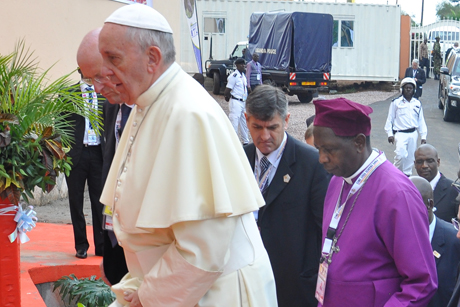
Pope Francis and Archbishop Stanley Ntagali enter the Anglican Shrine to the Ugandan Martyrs in Namugongo. Photo: Petero Buyondo and Francis Emorut
“The Roman Catholic martyrs died for the same Jesus Christ as the Anglican martyrs,” Archbishop Stanley said. “Together, they suffered; together, they sacrificed; together, they sang. Together, their blood has been the seed of the church in Uganda.”
It is a message that echoed Pope Francis’ words in July this year in St peter’s Square in Rome as he anticipated his visit to Uganda. “The blood of the martyrs makes us one,” he said. “We know that those who kill Christians in hatred of Jesus Christ, before killing, do not ask: ‘Are you an Evangelical, or [Anglican], or Orthodox?’ They say: ‘You are Christian,’ and behead them.”
Last week, the same message was repeated by the Preacher to the Papal Household, Father Raniero Cantalamessa, in a sermon at Westminster Abbey ahead of the Church of England’s General Synod: “In many parts of the world people are killed and churches burned not because they are Catholic, or Anglican, or Pentecostals, but because they are Christians,” he said. “In their eyes we are already one! Let us be one also in our eyes and in the eyes of God.”
Alluding to a traditional African proverb, Archbishop Stanley said, “If we want to go fast, let us go alone. As the wider Christian community in Uganda, however, if we want to go far, let us go together. This is why we were very happy to welcome the Pope of the Roman Catholic Church to the [Anglican] Church of Uganda.”
During the Pope’s brief visit to the Anglican Martyrs’ Shrine, he also emphasised the importance of prayer by kneeling at the torture tree and offering a personal prayer.
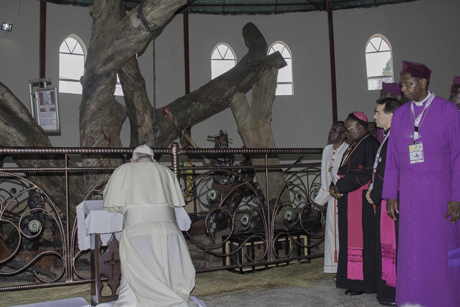
Pope Francis prays at the torture tree at the Anglican Shrine to the Ugandan Martyrs in Namugongo. Photo: Petero Buyondo and Francis Emorut
When he emerged from his private tour of the museum, he was welcomed by a very large, enthusiastic, and ululating crowd. He responded by inviting everyone to pray The Lord’s Prayer together.
The assembled congregation then received a double apostolic blessing with Pope Francis and Archbishop Stanley together conferring on everyone the Blessing of God Almighty: Father, Son, and Holy Spirit.
The House of Bishops of the Church of Uganda, along with the Provincial Heads of Laity and Clergy, the Provincial President of Mother’s Union, and several thousand Anglican clergy and laity arrived at the Martyrs’ Shrine at sunrise to prepare to welcome the Pope.
Retired Archbishop Livingstone Mpalanyi Nkoyoyo has spearheaded the development of the Uganda Martyrs’ Museum to ensure their legacy for future generations.
Pope Francis unveiled a dedication stone and offered a prayer that the Uganda Martyrs would continue to inspire generations of youth to follow Christ. Later in the afternoon he met thousands of Ugandan youth in Kampala to encourage them to pray and be faithful to Christ.
The President of Uganda and the First Lady were also present at the Anglican Martyrs’ Shrine.
Pope Francis is the third Pope to visit the Anglican shrine. Paul VI visited on 2nd August 1969; five years earlier, in 1964, he had canonized the Roman Catholic martyrs. Pope John Paul II visited on 7th March 1993.
- Anglican Communion ,
- Ecumenical & Interreligious
Press Release Service
- Episcopal Church Foundation designates April 16th as ECF Day to celebrate 75 years of service Episcopal Church Foundation
- Podcast: Easter and the profound significance of the resurrection The Episcopal Church in Southeast Florida
- Choirs sought for rare Carnegie Hall performance of Rutter’s Requiem Rugby School, UK
- EPF Lay Preacher Training Curriculum opens to all dioceses Episcopal Preaching Foundation
Featured Events
Featured jobs & calls.
- Priest-in-Charge Clarkesville, GA
- Rector Natchitoches, LA
- Rector Hertford, NC
- Regional Missioner Des Moines, IA
- Rector Cheyenne, WY
- Rector Santa Cruz, CA
- Rector Louisville, KY
- Cathedral Canon Seattle, WA
- Canon Vicar Indianapolis, IN
- Minister for Congregational Vitality Richmond, VA
- Interim Dean Detroit, MI
- Rector Panama City, FL
- Priest-in-Charge (PT) New Haven, CT
- Rector Lower Gwynedd, PA
- Minister of Communications Richmond, VA
- Rector Westerly, RI
- School Chaplain Charlotte, NC
- Associate Rector for Parish Life Jackson, MS
- Assistant/Associate Rector Morristown, NJ
- Associate Rector Shreveport, LA
- Rector Great Falls, MT
- Urban Garden Residency Omaha, NE
- Canon for Finance and Stewardship Charleston, WV
- Director of the Barrier Island Environmental Education Program Seabrook Island, SC
- Associate Rector Bryn Mawr, PA
- Priest-in-Charge (PT) Brant Lake, NY
- Rector Spring Hill, FL
- Priest-in-Charge Chattanooga, TN (St. Martin’s)
- Rector Bradenton, FL
- Rector Heppner, OR
- Vicar (PT) Half Moon Bay, CA
- Interim Rector / Rector Albany, NY
- Priest-in-Charge Meridian, MS
- Communications Manager (PT) Bastrop, TX or Remote
- Interim Priest Petaluma, CA
- Rector Taos, NM
- Rector Mt. Carmel, IL
- Priest-In-Charge Weston, MA
- Canon to the Ordinary Portland, ME
- Rector Grand Rapids, MI
- Rector Menasha, WI
- Rector Kansas City, MO
- Priest-in-Charge (PT) Pine Meadow, CT
- Cathedral Dean St. Petersburg, FL
- Priest-in-Charge Chattanooga, TN (St. Peter's)
Don’t miss a story from the Episcopal News Service. Sign up below to receive our daily or weekly newsletter.
How would you like to receive your news?
- Daily Newsletter
- Weekly Digest
By opting in, you also consent to receiving occasional sponsored emails with information we believe may be of interest. If you do not wish to subscribe or are already subscribed, please click the “X” button at the top right.
- EQUITY BANK
- SPECIAL REPORTS

Creation of the Artwork Nnyanzi explains that he was commissioned by Pan World Insurance to create a special gift for the Pope during his visit to Uganda. Drawing inspiration from his previous artwork titled “The Pentecost,” which had a similar theme, he meticulously sketched the piece and entrusted wood carving artist Ronald Wasswa Katumba to bring it to life. Wasswa carefully selected durable muvule wood known for its longevity in various weather conditions.
Artistry and Recognition Both Nnyanzi and Katumba recall the honor of creating a piece for the Pope. Beyond the recognition, they emphasize the substantial compensation they received, reinforcing their belief in the value of their artistic pursuits. Nnyanzi celebrated his artistic journey with an exhibition titled “Celebrating Forty Years of Brush Strokes from 1978 to 2018” at the Nommo Gallery in Kampala in 2018.
Conclusion Even though 30 years have passed since Pope John Paul II’s visit to Uganda, Nnyanzi and Katumba vividly remember the impact of their art on the Pope. Their illustrious careers in the art and culture sector continue to leave a lasting legacy in Uganda’s artistic landscape.
- Nuwa Wamala Nyanzi
- Pope John Paul II
Share post:
Ugandan Local Investors Call for Equal Treatment Amid Concerns Over Political Affiliations
Terrible two perish, 26 injured in jinja-kampala highway accident, besigye’s nationwide tours rattle amuriat, nandala and nup leadership, nrm’s cec yet to address controversial shs1.7 bn commissioners cash bonanza, top story investigative report exposes uganda’s role in illicit timber trafficking from congo, more like this related.
- Entertainment
The Standard Uganda is not just an independent news agency, but a real family of talent, a home of creative ideas and a place where powerful content is created for our clients and brands. As one of the largest independent media houses in East and Central Africa, The Standard Uganda attract and serve unparalleled audiences in Uganda, Rwanda, Tanzania, Democratic Republic Of Congo, South Sudan, Kenya and Burundi.
© 2024 The Standard UG All Rights Reserved.

Remember when Pope John Paul II visited Uganda and Kenya?
Cheridan sanders, friday, november 27, 2015.
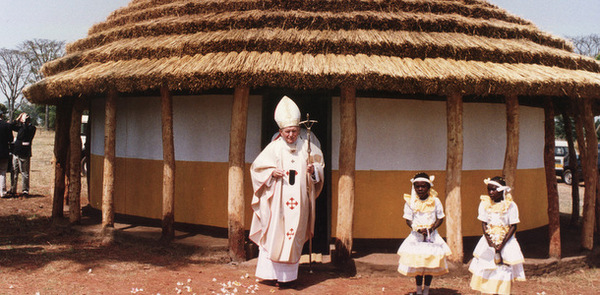
Related Articles:
Support label, other amount.

Thousands line up for pope's visit to Uganda

KAMPALA, Uganda (RNS) — Thousands of cheerful Catholics lined the streets near Entebbe International Airport on Friday, waving yellow-and-white Vatican flags, singing songs and ululating — the distinctive African trill — to greet the arrival of Pope Francis.
Many in the crowd had gathered before dawn, even though the pope didn't arrive until many hours later.
“We are happy today because Pope is finally coming here,” Kennedy Kiwanuka said. “Our prayers have been answered. We will keep praying during his stay here. We need his blessing.”
The pontiff’s six-day tour began in Kenya on Wednesday and will conclude in the Central African Republic on Sunday.
Pope Francis arrives in Africa for trip marked by high security
After greeting dignitaries, churchmen and groups of the faithful, the pope is scheduled to visit the Munyonyo Martyrs’ Shrine on Saturday, the spot where an African king in the 19th century ordered a massacre of Christians.
Francis is likely to discuss themes he raised in Kenya — confronting corruption, ending tribalism and religious animosity. He will also probably talk about economic development that benefits the poor rather than elites who retain a stranglehold over the region’s small-but-growing economy.
Preparations for the visit have taken place for weeks. At least 300 choir members held last-minute rehearsals at the shrine Friday morning as the pope concluded his visit in Kenya.
Ugandan Police Inspector General Kale Kayihura said his officers spent much of Friday sweeping neighborhoods and meeting with residents living in areas where Pope Francis and his entourage will pass during his visit. He said he wasn’t taking any chances.
“Terrorism is an animal which is difficult to define, and you can’t tell when or where it will strike,” Kayihura said.
A treatment center for the disabled in Kampala is among the last stops on the pope’s itinerary.
More than 700 sick, elderly and disabled people from several dioceses countrywide will gather there to meet the pope Saturday before he departs for the Central African Republic.
“We need a message of hope that can help some of us to accept the life we are going through,” said Lydia Namubiru, who lost her eyesight in a car accident.
The pope’s visit comes as Africa’s role in the Catholic church increases. Africa is a fast-growing continent for both Christians and Muslims, according to a report by Pew Research Center. Both Islam and Christianity are expected to gain more than twice as many adherents in the region by 2050. Christians are expected to increase in number from 517 million to more than 1.1 billion by 2050.
As the first pope from outside Europe in nearly 1,300 years, the Argentine pontiff has appointed more cardinals from Africa and the developing world to increase the continent’s role in decision-making in Rome.
Ugandans are conscious of the change.
“Uganda is one of the luckiest nations (in the world) to be able to host the pope,” Prime Minister Ruhakana Rugunda said. “This church in Africa is very well recognized, and it has played a very positive role in shaping people’s moral and spiritual development, promoting education, health and other related social economic development.”
Pope: Education, jobs will prevent radicalization
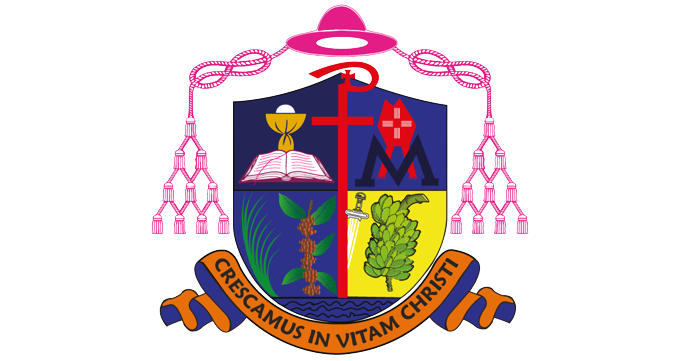
+256 414 270183(4)
[email protected], toll free: 0800-300-444.

Pope Paul VI’s Visit to Namugongo, 2nd August 1969
- Post author: kladmin
- Post published: June 19, 2020
- Post category: Uganda Martyrs
- Post comments: 0 Comments
During the 1967 Synode of Bishops in Rome, Archbishop Nsubuga had formerly invited Paul VI to come to Uganda and visit the site of the martyrdom of the 22 Ugandan martyrs he had declared saints in 1964. The Holy Father accepted in Principal but it was only in 1969 that the visit to Uganda was officially announced.
On 19 th March 1969 having cerebrated mass in honour of St. Joseph, Pope Paul VI addressed the Pilgrims in Rome in various languages and then declared ”we have often been earnestly invited by numerous Bishops and faithful to pay a special visit to Africa, more precisely to Uganda where work is progressing on a new shrine where an Alter has been erected in honour of the African martyrs whom we had the privilege of canonizing. It is desired that we preside over the consecration of that Alter at a ceremony to be attended by other African Bishops and faithful whose response to their Christian vocation is well known. We have accepted the invitation, we shall go to Kampala, Uganda’s capital, with the kind agreement of the civil authorities and with the intent to deeply desired on our part of meeting a number of Bishops of African continent already convoked for their meeting there. We shall have in our heart the spiritual and civic destiny for all Africa.
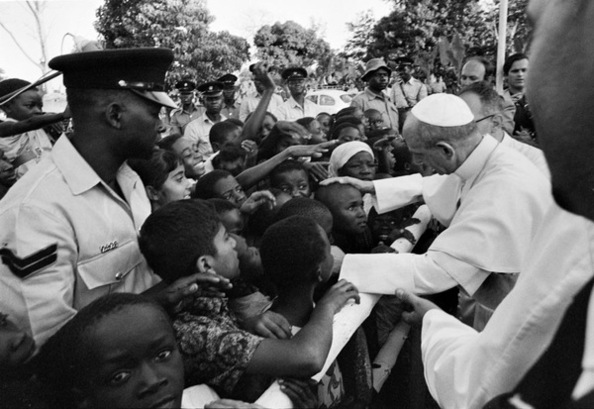
Uganda was the first African Nation the Roman Pontiff to visit. It was the 31 st of July 1969 in the aftermath of the 2 nd Vatican council. Pope Paul VI was welcomed at Entebbe International Airport where he greeted the people of Africa and Ugandan.
The Holy Father then celebrated mass in Kampala (at the conclusion of the Symposium organized by the Bishops of Africa) before meeting with the President Apollo Milton Obote on Friday 1 st August, he began with the Episcopal ordination of 12 Bishops in Kololo, Pope Paul VI then met with the members of Parliament of Uganda, the Diplomatic corps, the faithful in the Parish of N sambya, the sick in the Hospital of Mulago, the faithful of the Village of Mengo, those at the center for Human Promotion, the sick in the Hospital of Lubaga, members of Catholic Action and other Catholic
Associations of Uganda, members of the Catholic Church in Uganda and finally with dignitaries and representatives of Islam. On his final day of pilgrimage, Pope Paul VI visited the shrine of Namugongo, met with members of Anglican Church of Uganda and then the civil and religious authorities of Kampala before giving the final address to the faithful of Uganda in the Cathedral of Lubaga ahead of the farewell ceremony.
You Might Also Like
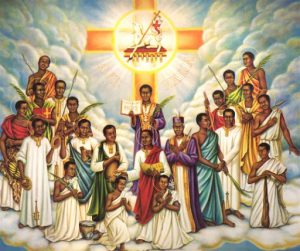
Who are the Uganda Martyrs?

Mapeera Y’ani?
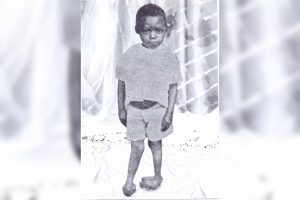
Ekyewuunyo kya Revokato Kalema
Leave a reply cancel reply.
Save my name, email, and website in this browser for the next time I comment.
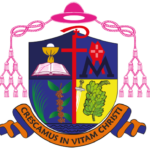
Quick Links
- Clergy Only
- Privacy Policy
- Terms of use
- Phone: +256 414 270183 +256 414 270184
- Toll Free: 0800300444
- Fax: +256 414 345441
- Email: [email protected]
- P.O.Box 14125, Kampala Uganda
- Phone: +256 414 270183/4
archdiocesan offices
Additional resources.

Pope Fancis’ Visit to boost Uganda’s tourism
- July 1, 2015
- Uncategorized
Pope Fancis’ Visit to Uganda to boost its tourism Following this year’s announcement by Pope Francis that he will visit Uganda in November, there have been excitements from different parts of the country and also from foreign countries. Many nationals especially Christians welcomed the good news with celebrations since it has been a long time since Uganda last hosted a pope. This year’s visit will be a record breaking visit in Africa with Uganda becoming the fourth most visited country by the pope on the planet. It will be the third time for this East African country to have a chance of hosting the religious leader. Few countries in Africa have had a chance of hosting the pope at least two times and these include; – Angola, Cameroon and Benin.
It should be noted that Uganda first hosted a pope in 1969 five years after the martyrs were canonized. He visited the various places were martyrs were killed from and also other holy places. Pope Paul VI again visited Uganda in 1993.From then; this pearl of Africa has been yearning to see the pope again. Last year, there was some hope but this was shattered after pope Francis announced that due to their busy schedule he could not make it. Ugandans never lost hope and this year their faith has been rewarded by the acceptance of the man on God to visit the nation.
However, tour operators too are expecting to gain from this visit as it will market the country’s fraternities to the rest of the world. Many people from different continents will be persuaded to explore more about this East African country as a result of pope’s visit. Being the fact the he will visit some cultural and religious sites like Namugongo shrine, it will help in boosting the country’s tourism as tourists will pick interest in visiting the place too. Off course he will come together with other delegates and one thing for sure is that they will be amazed by the breathtaking atmosphere in the country full of natural wonders. They will go back to their home countries and spread the gospel about this wonderful country hence acting as tourism marketing agents.
Hopefully this upcoming event will help in boosting the country’s tourism which has of lately been affected by various happenings in the world.
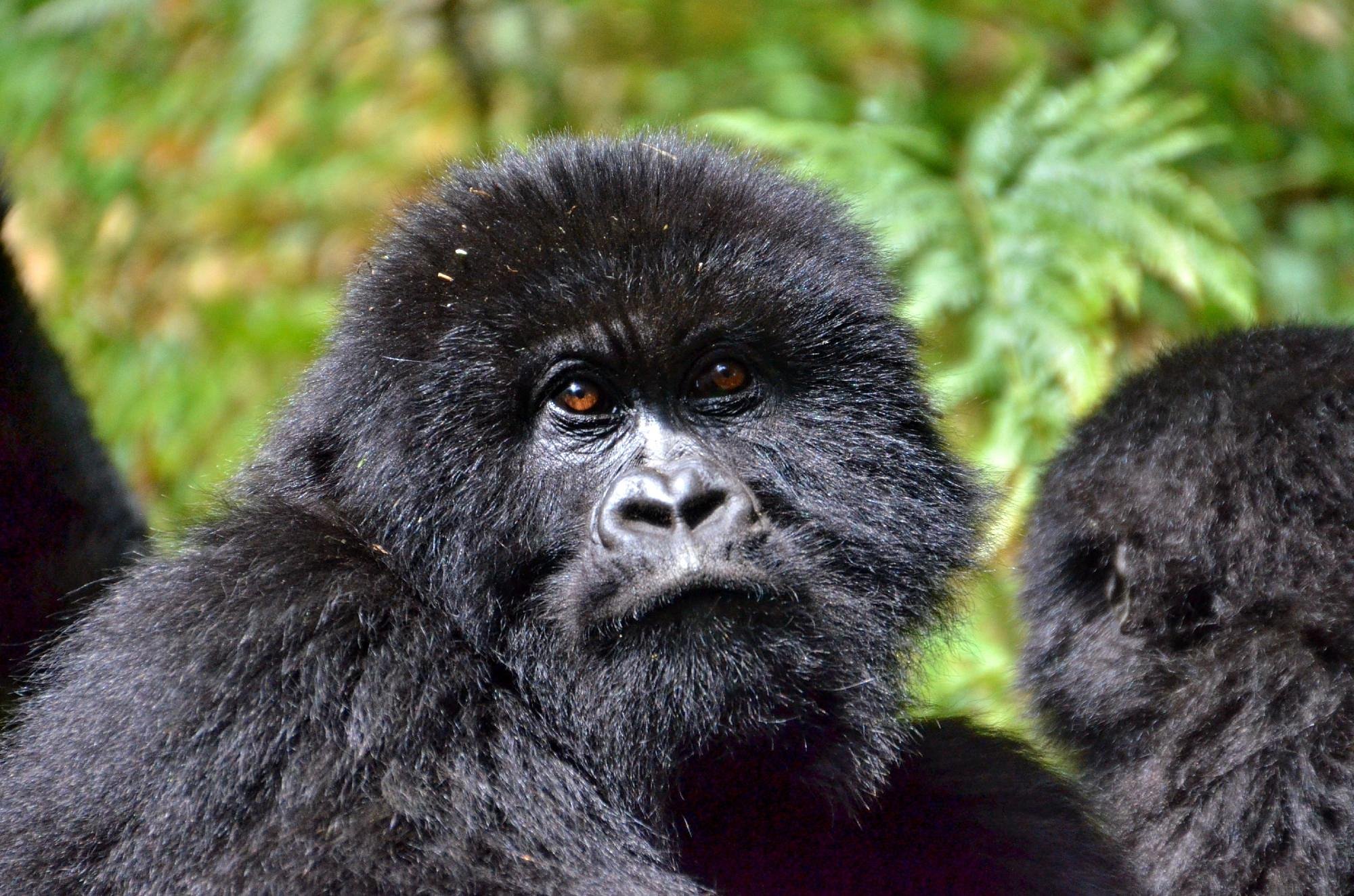
Things You Should Never Do Around Mountain Gorillas
Things You Should Never Do Around Mountain Gorillas Gorilla Trekking within Uganda, remarkable Rwanda and…
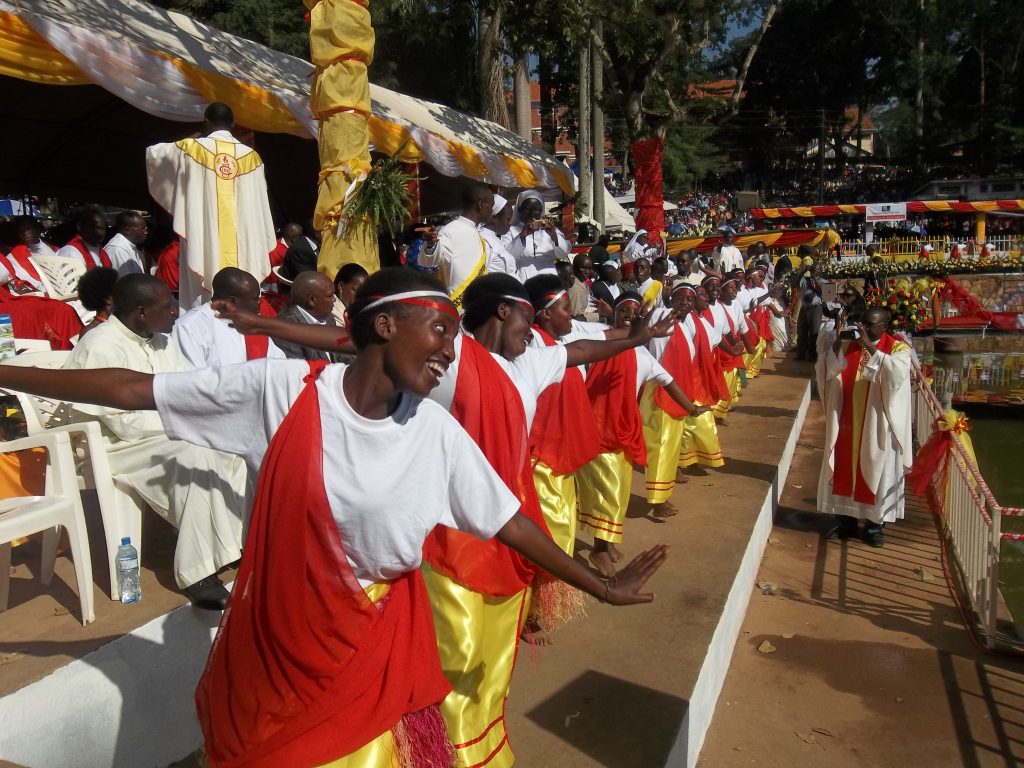
How does Uganda Martyrs Day Contribute to Tourism
The 3rd of June every year is an important time in Uganda’s Calendar because it’s…
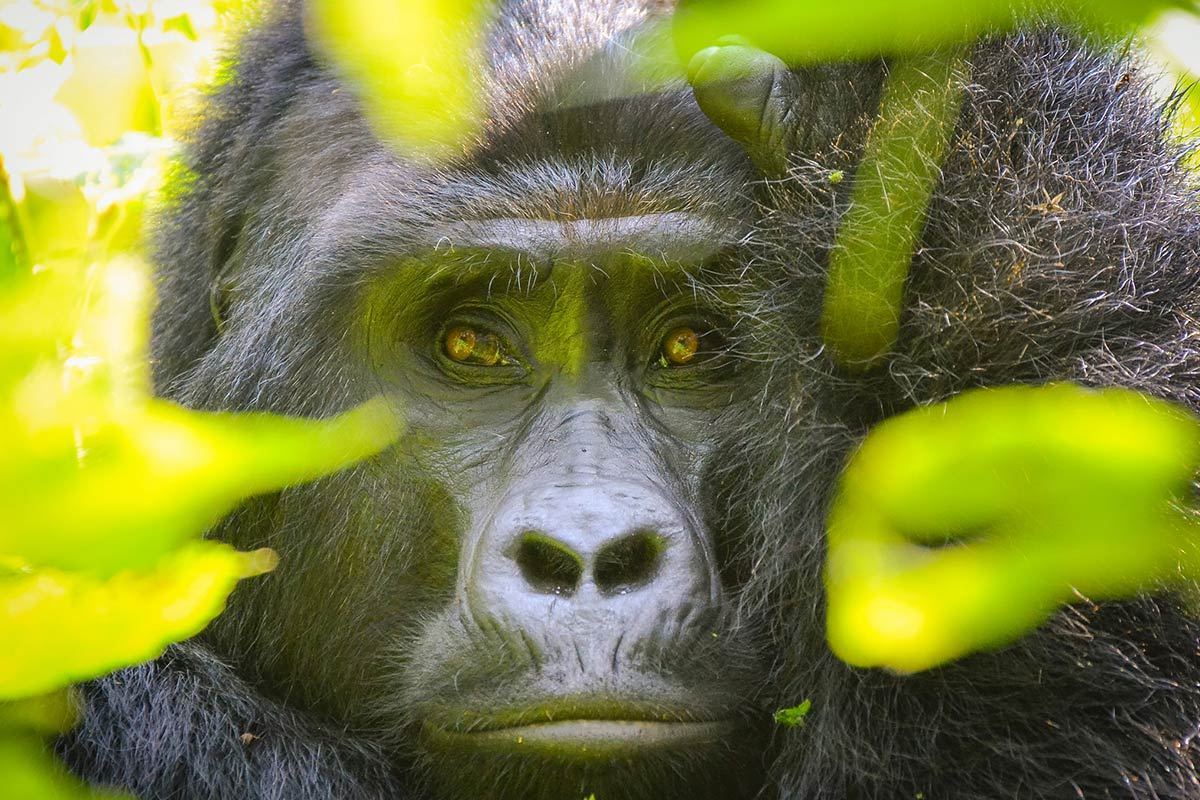
3 Days Uganda Gorilla Trekking in Nkuringo
3 Days Uganda Gorilla Trekking in Nkuringo Overview 3 days Uganda gorilla trekking Nkuringo takes…
- previous post: About Mountain hiking safaris Uganda
- next post: Gorilla Trekking tours in Uganda
New study expresses ‘grave concerns’ over definition of ‘brain death’
Hungarian politician praises pope, condemns ‘woke’ politics ahead of eu elections.

The Order of Malta’s Grand Chancellor Riccardo Paternò di Montecupo meets Tristan Azbej, Hungary’s State Secretary for Aid to Persecuted Christians, on April 8, 2024. (Credit: Sovereign Order of Malta.)
ROME – Hungary’s State Secretary for the Aid of Persecuted Christians and a leading member of the country’s Christian Democratic People’s Party has lauded Pope Francis’s condemnation of so-called “ideological colonization,” and his call for Europe to return to its founding values.
Speaking to Crux April 8 as part of a whirlwind trip to Rome, Secretary Tristan Azbej referred to the common practice of Western governments including condoms in aid packages for developing nations or making humanitarian support for needy countries contingent on making legal provisions for abortion and gay rights.
“Some of these liberal or woke ideology governments, instead of going there to these communities, asking what is the real need, they try to follow their own agenda,” Azbej said, adding, “This, I would say, is moral insanity.”
“This is the liberal, political, ideological colonization that we see. It is utterly disrespectful, and the Holy Father said it very rightly, this is a colonization of those countries…that is not only threatening, but utterly immoral, inhumane.”
Azbej also referred to Pope Francis’s call for Europe to return to its Christian roots and the call of European bishops for political leaders to embrace anew the continent’s founding Christian values ahead of EU parliamentary elections in June.
As elections approach, “We see a very strong push from the agenda-lobby, in Brussels, in European politics, in Western politics, but we are combatting that because we want to adhere to our core values,” Azbej said.
“We’ll see if the traditional political forces that uphold the traditional building stones and values of European civilization will get stronger, or to the contrary, the woke movement will gain more ground,” he said.
Azbej, whose office falls within the Hungarian Foreign Ministry, also serves as head of the Hungary Helps humanitarian agency, which provides on-the-ground support for persecuted Christian communities and communities impacted by various humanitarian crises, and he is Vice President of Hungary’s Christian Democratic People’s Party.
He was traveling to Rome to meet with officials inside of the Italian government, as well as representatives of the Holy See and the Sovereign Order of Malta.
In his conversation with Crux , Azbej discussed the scale of global anti-Christian persecution and what he said was a lack of international political will to the fight against it, as well as the importance of forging church-state networks, the upcoming EU elections, and current projects assisting at-risk communities.
Please read below for excerpts of Crux ’s conversation with Hungarian State Secretary for the Aid of Persecuted Christians Tristan Azbej:
Crux : Can you explain what you’re doing in Rome and what your objectives are with the various meetings you are holding?
Azbej : One part of my mission this time, in my visit to Rome, is to meet and consult with high-ranking officials of the Holy See, and today I have also met with the Grand Chancellor of the Sovereign Order of Malta. For years now we have been working together with the Sovereign Order of Malta out of many countries, for example Lebanon, where we support social care and education institutions of the Order that are Catholic by spirit, but serve all people of Lebanon regardless of their faith. So, part of this visit is that we have consulted with the Order of Malta regarding what can the Vatican do in the Middle East, in Africa, and in the crisis zones of the world, for example, in Ukraine or in Gaza.
Similarly, we have built partnerships with the Catholic Church, with dioceses, and Catholic charities all around the world. We have discussed our experience, because for us as a government it is unusual to work so closely, directly engaged with churches and faith communities, and also, we have discussed what is the best possible answer we can give to ongoing conflicts and crises in the world.
For a long time, we have been one of the very few governments, because Christianity is the most persecuted religious group in the world, and also because we are a Christian Democratic Government of a Christian nation, to have such a dedicated program. Eventually over time we have found a very few like-minded governments who had sensitivity to religious freedom issues, and one possible such partner is the Italian government.
The Italian government made a very big and important step that we can only commend, when last year they created the Office of Special Envoy for Religious Freedom. We are initiating talks with the Foreign Ministry and the Italian Agency for International Development (AICS), to compare methodologies and seek common projects and common areas of interest where we can work together to benefit the developing world, to provide aid to suffering people, with faith-based involvement.
What is the importance for you in engaging with state but also faith leaders in this conversation? How important is this network?
There are more than 300 million people in the world who are discriminated (against) or targeted, or even persecuted by oppressive organizations because they are Christian. More than 300 million, by far this is the largest group of people in the world that is persecuted because of their identity. We are talking about one of the biggest human rights crises of our time. It shouldn’t be left to charities, the international community, including governments, including big donors, including international organizations, including the European Union and the United Nations, should step up for that.
We work together with charities and the Holy See because we are learning from them and we are building the closest, most direct possible connection to these communities we work for, but we also want to influence political actors and governments to follow this example and recognize the magnitude of this humanitarian and this global human rights crisis.
Then a separate issue is to help and support those suffering people, communities in crisis, who are in a crisis that doesn’t involve faith-based persecution, who are involved in man-made disaster areas, or natural disaster areas, or the people in the poorest countries in the world, or in war zones. In that case, our experience after more than six years of the aid program Hungary Helps, is that even for non-Christian people in crisis, Christian charity organizations prove to be the most efficient, most direct and most trustworthy humanitarian partners.
This is difficult diplomatic work, most Western governments, mostly governed by liberal parties, refuse to work together with the Christian organizations because they claim that it is not politically correct to work with them, they claim that working through such an organization goes against the humanitarian principle of neutrality and impartiality. But we think this claim is false because the social mission of the Church is specifically open to all people, not only to Christians, and those governments and big donors who most of the time have way more money than the Hungarian government…sometimes they exclude the only way to reach the most vulnerable people in faraway lands.
Pope Francis often speaks about “ideological colonization” when aid is sent to developing nations, with the reception of that aid contingent on the acceptance of certain provisions for issues such as abortion and contraception. How common would you say this experience of “ideological colonization” is in the allocation of humanitarian aid, and what do you think of Pope Francis’s condemnations of it?
I not only agree with these statements from the Holy Father, but I can confirm it based on my personal experience on the ground. I can give you one example of what I have experienced: it was Uganda, where there was great humanitarian need back in that time and they were in need of pharmaceuticals and medicines, and humanitarian fast relief.
What happened is that one of the greatest donors among the Western countries, the humanitarian response was sending big shipments of contraceptives. They were shocked to see huge shipments of condoms, and this is the problem, because some of these liberal or woke ideology governments, instead of going there to these communities, asking what is the real need, they try to follow their own agenda.
That’s one mistake. The other mistake is in many cases, some European member states and sometimes even the EU is guilty of that, they only provide much-needed humanitarian development assistance if the beneficiary country is making amendments to its legal system according to woke ideals, if they legalize abortion, if they legalize so-called ‘gay marriage,’ and so on. This, I would say, is moral insanity. How can you ask from a government that in return for much-needed humanitarian support, as a government they influence their own legislative branch to pass certain laws.
This is the liberal, political, ideological colonization that we see, and this is not only happening politically speaking, but it is utterly disrespectful, and the Holy Father said it very rightly, this is a colonization of those countries…that is not only threatening, but utterly immoral, inhumane.
Pope Francis has called Europe, and the bishops of Europe have also called political leaders, to return to Europe’s founding principles and Christian values ahead of parliamentary elections this June. How important is this call, do you think, as elections approach?
I can give you the Hungarian perspective. Hungary, at least culturally, is a Christian country, and we as a Christian Democratic government, have a mission to implement the social teachings of the bible and the Church into our policy, including protecting marriage, including protecting the concept and only true definition of family.
We see a very strong push from the agenda-lobby, in Brussels, in European politics, in Western politics, but we are combatting that because we want to adhere to our core values. Seeing how powerful this lobby is in EU legislation and EU institutions, we made preventive measures by amending our constitution. In our constitution, we protect the definition of family and of marriage, and we proclaim in the constitution that marriage is between one man and one woman, and that a father is a man, and a mother is a woman. Where has our world reached, when such a thing needs to be set in constitutions?
After amending our constitution, the amount of political attacks from EU politics has amounted on Hungary, and became ever-more severe. That will have another round during the European elections. We’ll see if the traditional political forces that uphold the traditional building stones and values of European civilization will get stronger, or to the contrary, the woke movement will gain more ground.
Going back to your work with Hungary Helps and with the issue of anti-Christian persecution, it’s sort of fallen out of global discussion. What is the best way to keep raising awareness about the importance of this issue?
The basic human right of human freedom and belief should be more discussed and observed, not only for Christians, but for all. When we talk about human rights, somehow the right of religious freedom is less on the agenda of international organizations. People and politicians feel that it is a sensitive topic, it is hard to address, therefore they fail to do so. So, first of all, religious freedom has to be protected.
Then, the plight of persecuted Christians has to be first recognized, and we are not there yet. There is still denial in the West that Christians are persecuted. This denial is mostly politically motivated, or maybe out of bad conscience, we know that. We don’t think that any Christians would want to engage in a competition of victimhood, that’s not the point.
We shouldn’t protect Christians at the expense of other persecuted and discriminated groups, but so far in some in international organizations and in the big diplomatic forum, there is not even a recognition that such a phenomenon of anti-Christian persecution exists, and we need to change that.
Christians are murdered by the thousands each year because they follow Jesus Christ…each day on average 13 Christian people are murdered for religious reasons. The attacks against Christian institutions have tripled in one year, the registered cases last year were 14,000, the fiscal attacks against Christian institutions. So, we should be not only recognizing the issue, we should be sending tangible aid and protection to these communities, and we are trying to inspire more resources from more experienced governments in the West, to also work in such a direct way to assist these groups.
Any new projects or initiatives on the horizon in this regard?
On the side of persecuted Christians, we have started our first projects in the Middle East. Since ISIS collapsed, there is no murderous persecution against Christians in Iraq and Syria, but the 2,000-year-old Christian communities in these countries have shrunk to a fraction of their former size, and their institutional background and presence is very, very weak, and they might not have a future. So, in the Middle East we continuously support the institutions.
Regarding bloody, murderous Christian persecution, Nigeria is where 90 percent of the murdered Christians were killed last year, so there we are sending humanitarian fast relief to support the victim-survivors and family members of anti-Christian terrorist attacks, and also the internally displaced Christians who will not receive food, shelter or any provisions except from the limited capacities of the dioceses, so this is what we are currently working on and starting new projects.
When we’re looking at the general humanitarian activities of our program, then we are very active with faith-based engagement in Gaza. Once again I need to underline that the Gaza conflict has no, or a very small religious context, it is a political and ethnic conflict. Because we don’t see any other accessible and trustworthy humanitarian partners, we work through the Catholic Church, the Latin Patriarchate of Jerusalem, in giving humanitarian support to the civilian population of Gaza, and also in the West Bank.
Follow Elise Ann Allen on X: @eliseannallen
For the cost of a cup of coffee at Starbucks, you can help keep the lights on at Crux.

Tuesdays on

Crux . Anytime . Anywhere .
Today’s top stories delivered straight into your inbox.

Ukrainian seafarers ‘distressed’ and ‘worried’ because of war, Catholic charity says
- Charles Collins
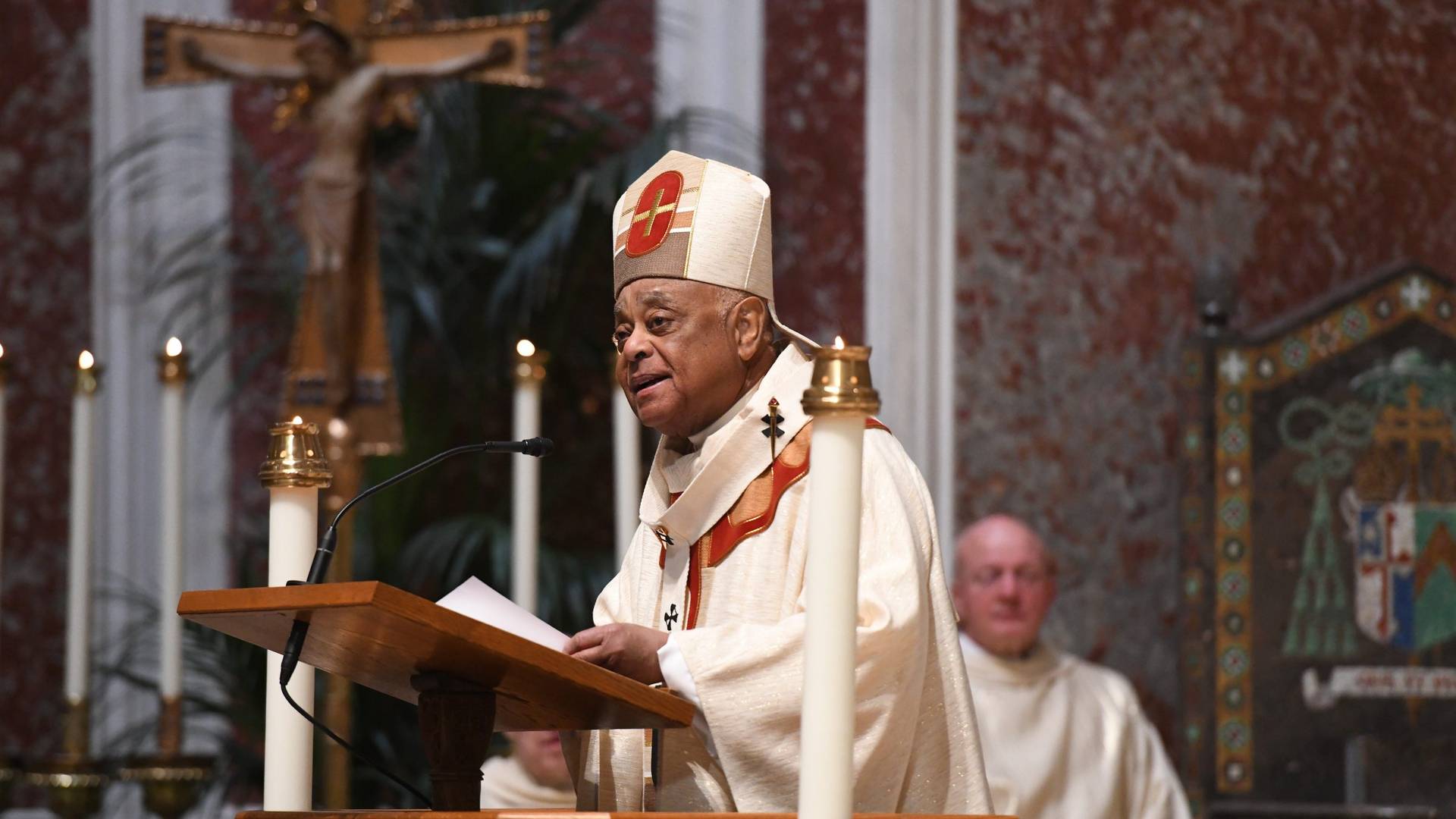
DC cardinal says LGBTQ Catholics are welcome, but Church has its rules
- Elise Ann Allen

Cameroon archbishop explains country’s multi-faceted crises
- Ngala Killian Chimtom
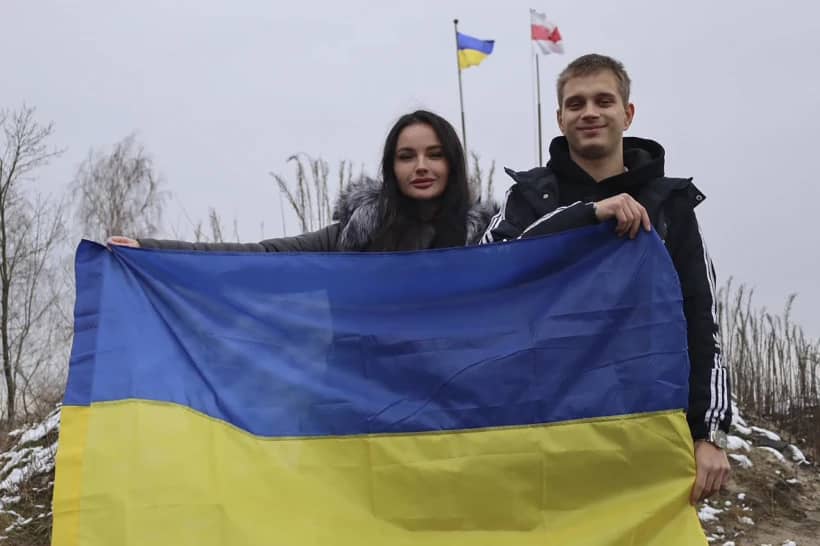
Major Archbishop says Russia using ‘diabolical tactics’ against Ukraine

Criminals attack Church facility in Odisha state in India
- Nirmala Carvalho

Pope Francis to visit Asia and Oceania in September
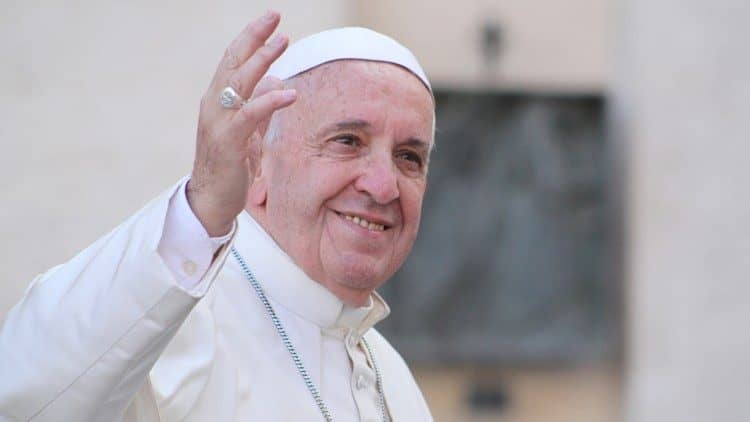
U.S. Catholics support for Pope Francis still high, but lower than before
- John Lavenburg

California bishop praises district attorney’s decision to reset death penalties

- Election 2024
- Entertainment
- Newsletters
- Photography
- Personal Finance
- AP Investigations
- AP Buyline Personal Finance
- Press Releases
- Israel-Hamas War
- Russia-Ukraine War
- Global elections
- Asia Pacific
- Latin America
- Middle East
- Election Results
- Delegate Tracker
- AP & Elections
- March Madness
- AP Top 25 Poll
- Movie reviews
- Book reviews
- Personal finance
- Financial Markets
- Business Highlights
- Financial wellness
- Artificial Intelligence
- Social Media
Pope will travel to Indonesia, Papua New Guinea, East Timor and Singapore in longest trip of papacy
FILE -Pope Francis waves as he leaves after his weekly general audience in St. Peter’s Square at The Vatican, Wednesday, April 10, 2024. Pope Francis will visit Indonesia, East Timor, Papua New Guinea and Singapore in September, the Vatican announced Friday, April 12 ,2024, confirming the longest trip of Francis’ papacy that is sure to test his health, stamina and mobility. (AP Photo/Andrew Medichini, File)
- Copy Link copied
VATICAN CITY (AP) — Pope Francis will visit Indonesia, East Timor, Papua New Guinea and Singapore in September, the Vatican announced Friday, confirming the longest trip of Francis’ papacy that is sure to test his health, stamina and mobility.
The Vatican confirmed the Sept. 2-13 visit, saying the 87-year-old pope would visit Jakarta, Indonesia; Port Moresby and Vanimo, Papua New Guinea; Dili, East Timor; and Singapore. Further details will be announced later.
Francis’ health has become a source of increasing concern and speculation, even though the pontiff is able to carry on with a rigorous schedule of meetings at the Vatican and even excursions to local parishes.
Francis, who had part of one lung removed as a young man, had to cancel a planned visit to Dubai late last year after he came down with a bad case of bronchitis. He suffered from respiratory problems all winter and had to curtail his participation in Holy Week events to save his energy for Easter.
Francis has also been using a wheelchair for nearly two years because of bad knee ligaments, and has said that traveling has become increasingly more difficult.
And yet at 11 days, the trip would be the longest of Francis’ papacy, outpacing by a few days some of his long trips to the Americas early on in his 11-year papacy. It will bring the Argentine Jesuit to the world’s most populous Muslim nation, Indonesia, as well as the former Portuguese colony of East Timor, where the Catholic Church wields enormous influence.
There is also a chance of another leg to the trip being added later: This week, the Vatican foreign minister, Archbishop Paul Gallagher, was in Vietnam and discussed a papal visit, Vatican News reported, without providing details.
In a statement announcing the visit, the Indonesian foreign ministry welcomed the visit and recalled that it had originally been scheduled for 2020 but was postponed because of the COVID-19 pandemic.
“The visit of Pope Francis to Indonesia holds significant importance to the Indonesian people, not only for Catholics but also for all religious communities. The visit is also expected to strengthen the message of tolerance, unity and world peace,” the statement said.
Indonesia is home to roughly 242 million Muslims and 29 million Christians — 8.5 million of whom are Catholics — according to a 2022 report by the Religious Affairs Ministry.
East Timor, which today has a population of about 1.2 million people, is Southeast Asia’s only predominantly Christian nation with the exception of the Philippines. According to the 2015 census, 97.6% of East Timor’s population is Catholic.
The visit to East Timor will likely reignite attention over a clergy sex abuse scandal involving its revered independence hero and Nobel Peace Prize winner. The Vatican confirmed in 2022 that it had sanctioned Bishop Carlos Ximenes Belo following allegations that he sexually abused boys there during the 1990s. Belo is believed to now be living in Portugal.
Francis will be the first pope to visit Papua New Guinea since St. John Paul II went there in 1984. The country, in a strategically important part of the South Pacific, has struggled with tribal violence and civil unrest.
John Paul also visited Singapore, in 1986. The country today is home to 395,000 Catholics and Francis in 2022 made its archbishop Singapore’s first cardinal.
In a statement welcoming the visit, Cardinal William Goh, said it “will bring renewed fervor to all Catholics in Singapore, uniting them in faith and mission, especially in these most challenging of times.”
The Vatican has planned only one other papal trip this year — to Belgium to celebrate the anniversary of the country’s Catholic university. Francis has also said he wants to return to his native Argentina , but no plans or dates have been announced.
Karmini contributed from Jakarta, Indonesia.

IMAGES
VIDEO
COMMENTS
Pope Francis is in Uganda in the second leg of his week-long visit of Africa. There was a joyous welcome as the popemobile made a tour around where the Mass ...
He arrived in Uganda from Nairobi, Kenya on November 27. Again like his two predecessors, Pope Francis came to Uganda as a pilgrim to venerate the Holy martyrs, at Namugongo shrine. Archbishop Dr. Cyprian Kizito Lwanga, initiated Pope Francis's pastoral visit to Uganda during an audience with the Holy Father in 2013.
Pope Paul VI bucked the trend and became the first reigning pope to visit Africa. It was a major event when he visited Uganda in 1969. Among other activities, Paul VI made a pilgrimage to the ...
By Devin Watkins. Uganda's Prime Minister Robinah Nabbanja met on Monday with Pope Francis at the Vatican's Apostolic Palace. The encounter lasted around 25 minutes and saw the Pope and the prime minister discuss various issues, according to Matteo Bruni, the Director of the Holy See Press Office. "Among the topics covered during the ...
The pope also visits the St. Peter and St. Paul Church in Cairo, which had been the site of a bombing in December 2016, resulting in 29 deaths and many injuries. ... Uganda: 27-29 Nov. Francis visits to Uganda, marking the first time a pope visited the East African country in almost 30 years. In his speeches, Francis emphasizes the importance ...
The Pope's visit coincides with the celebration of the Church marking 50 years of the canonization of the Uganda Martyrs. He is the 3rd reigning Pope to visi...
Then Paul VI touched down on the tarmac, and on July 31, 1969, became the first reigning Pope to ever visit Africa. "Roman Catholics number about 3,000,000 in Uganda—one of Africa's most ...
Pope Francis visits Uganda and holds Mass for martyrs 01:36. NAMUGONGO, Uganda --Pope Francis on Saturday honored the Ugandan Christians who were burned alive rather than renounce their faith a ...
February 7, 1993: Pope John Paul II blesses Ugandans at a mass in Namugongo, on the third day of his five-day visit to Africa. Later that day the pope was scheduled to visit Nsambya hospital and ...
Dear Pope Francis, We're excited to welcome you to Uganda. Catholics make up nearly half of the Christian population here — and they're eager to meet you!. Our's is a lovely country.
"The Christian community in Uganda grew strong through the witness of the martyrs," said Francis, the third pope to visit Africa. "The message you bring will take root all more firmly in people's ...
Should the Pope visit Uganda as he hinted, this will be his first trip to Africa since he was elected Pope in March 2013. He succeeded Pope Benedict XVI who resigned in February 2013, citing a ...
Pastoral visits of Pope Francis This is a list of pastoral visits of Pope Francis. His visit to the Philippines in January 2015 included the largest papal event in history with around 6-7 million attendees in his final Mass at Manila, surpassing the then-largest papal event at World Youth Day 1995 in the same venue twenty years earlier. International visits 2013 Pope Francis visits a favela ...
Gerard O'Connell November 28, 2015. Pope Francis has ended his visit to Uganda and tomorrow morning he will board the plane that will take him to the conflict-ridden Central African Republic, as ...
The President of Uganda and the First Lady were also present at the Anglican Martyrs' Shrine. Pope Francis is the third Pope to visit the Anglican shrine. Paul VI visited on 2nd August 1969; five years earlier, in 1964, he had canonized the Roman Catholic martyrs. Pope John Paul II visited on 7th March 1993.
Renowned artist Nuwa Wamala Nnyanzi recalls the impact of his artwork on Pope John Paul II during his visit to Uganda in 1993. While younger generations may remember Pope Francis' visit to Uganda in 2015, the older generation holds cherished memories of past papal visits, especially those of 1993 and 1969. Renowned Ugandan multimedia visual […]
Interestingly Uganda was the very first African nation a Roman Pontiff was ever to visit. It was the 31st of July 1969 in the aftermath of the Second Vatican Council and the pope was Blessed Paul VI:"For the first time history", he said upon his arrival at Entebbe airport, "the Successor of Peter as Vicar of Christ sets foot upon the soil ...
And here in this photo, Kenyans greet Pope John Paul II with music in Nairobi in September 1995. 1995 was a busy year of travel for Pope John Paul — 12 countries in all. Don't miss a minute of Pope Francis' historic trip to Kenya, Uganda and the Central African Republic. Watch it all right here on Salt and Light. CNS photo from L'Osservatore ...
Francis' six-day visit to Africa began in Kenya amid tight security and will end Sunday. ... Thousands line up for pope's visit to Uganda. Tonny Onyulo. Religion News Service. KAMPALA, Uganda (RNS ...
Tuesday, November 10, 2015 — updated on January 20, 2021. Pope John Paul II waves to the faithful at Namugongo during his visit to Uganda in 1993. Inviting the Pope. Preparations and arrival ...
Pope Paul VI in Uganda 1969. Uganda was the first African Nation the Roman Pontiff to visit. It was the 31 st of July 1969 in the aftermath of the 2 nd Vatican council. Pope Paul VI was welcomed at Entebbe International Airport where he greeted the people of Africa and Ugandan. The Holy Father then celebrated mass in Kampala (at the conclusion ...
Pope Francis Visits Uganda 2015, Vatican City. 1,399 likes. Pope Francis will visit Uganda in November 2015 on the occasion of the Golden Jubilee for the canonisation of the Uganda martyrs.
Pope Fancis' Visit to Uganda to boost its tourism Following this year's announcement by Pope Francis that he will visit Uganda in November, there have been excitements from different parts of the country and also from foreign countries. Many nationals especially Christians welcomed the good news with celebrations since it has been a long ...
ROME - Hungary's State Secretary for the Aid of Persecuted Christians and a leading member of the country's Christian Democratic People's Party has lauded Pope Francis's condemnation of ...
FILE -Pope Francis waves as he leaves after his weekly general audience in St. Peter's Square at The Vatican, Wednesday, April 10, 2024. Pope Francis will visit Indonesia, East Timor, Papua New Guinea and Singapore in September, the Vatican announced Friday, April 12 ,2024, confirming the longest trip of Francis' papacy that is sure to test his health, stamina and mobility.